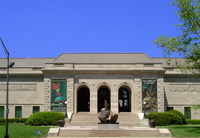 Local Trumps Global
Local Trumps Global
Museums get going with homegrown talent The Cincinnati Art Museum's expansion plans remain on hold amidst difficulty fundraising.
Courtesy CAM
The economic downturn is reshaping American museum expansions. Recently, two well-known museums have cancelled plans by internationally known firms and commissioned more modest projects by local firms, while a third high-profile addition remains on hold.
The Architect’s Newspaper has learned that after commissioning a masterplan and addition by Tod Williams Billie Tsien & Associates (TWBTA), the Columbus Museum of Art (CMA) has discontinued their services and is moving ahead with a scaled-back addition by Columus-based DesignGroup, which had been the architect of record on the project. “The original plan was for Tod and Billie to do all the work. But with the economy being what it is, we needed to find a way to make it more cost-effective,” said Nannette Maciejunes, executive director of the CMA.
Maciejunes commends the planning work that TWBTA did on the project, and considers DesignGroup’s work a “refinement” of TWBTA’s design. “It’s not only to be cost-effective, it’s about developing local talent,” Maciejunes said. “It’s about keeping those dollars in our community.”
“I feel unhappy not to do the project, but I’m happy that DesignGroup is taking it over,” Billie Tsien told AN. “Life is too short for hard feelings, and I like those guys.” Tsien feels that DesignGroup’s work will be its own. “So much of our architectural persona is dependent on detailing and execution,” she said. In addition, Tsien believes the landscape for commissioning new cultural buildings has changed, and now all elements of a project are more likely to be scrutinized by a broader spectrum of stakeholders. “The discipline becomes tauter,” she said.
In late March, the Wadsworth Atheneum in Hartford, Connecticut, announced a renovation by local architects SmithEdwards. They had previously canceled a $50 million addition by UNStudio. The museum is housed in a string of five buildings, and the project will include interior improvements, new roofs, and facade repairs, as well as reorganized mechanical systems and a reopening of sealed-off areas, netting the museum 8,000 square feet of additional gallery space. “Our main concern was less about design than about finding a firm that excelled at preservation and engineering,” said Susan Talbott, Wadsworth’s director.
Talbott believes the renovation will celebrate the institution’s history as the country’s oldest continuously operated art museum, reinforcing its core mission. “What I hear are the woes of colleagues who have invested hundreds of millions of dollars for massive expansions, and how difficult it can be to run, support, and maintain them,” she said. The Wadsworth’s renovation is budgeted at a mere $16 million, all of which has been raised.
The Columbus Museum of Art has given a renovation by Tod Williams and Billie Tsien over to the project's executive architect, local firm DesignGroup.
Courtesy biocrawler.com
At the Cincinnati Art Museum, a planned addition by the Dutch firm Neutelings Riedijk has been put on hold, while a more modest renovation of an existing building proceeds. “We are currently taking a breather from our institutional campaign. We are proceeding with raising funds for renovation of the Art Academy building, a structure we inherited several years ago,” Aaron Betsky, director of Cincinnati Art Museum, wrote in an email. “We hope to transform this into office and public space, freeing up significant areas within our existing building for education and exhibitions.”
Betsky said Neutelings Riedijk never wanted to work on this portion of the project, and much of the funding for that phase is already in hand. “We have so far received a pledge of $2 million for this, as well as $1.5 million of state capital allocations, and are pursuing additional funding.”
Maciejunes and Talbott agree that the economic climate has changed how many institutions plan for the future. High-profile architecture may not be a priority. “It depends on each museum and on community support,” Maciejunes said. “In the end, you’ve got to figure out how to get it done.”
 Local Trumps Global
Local Trumps Global